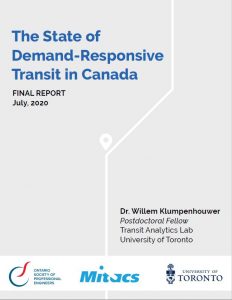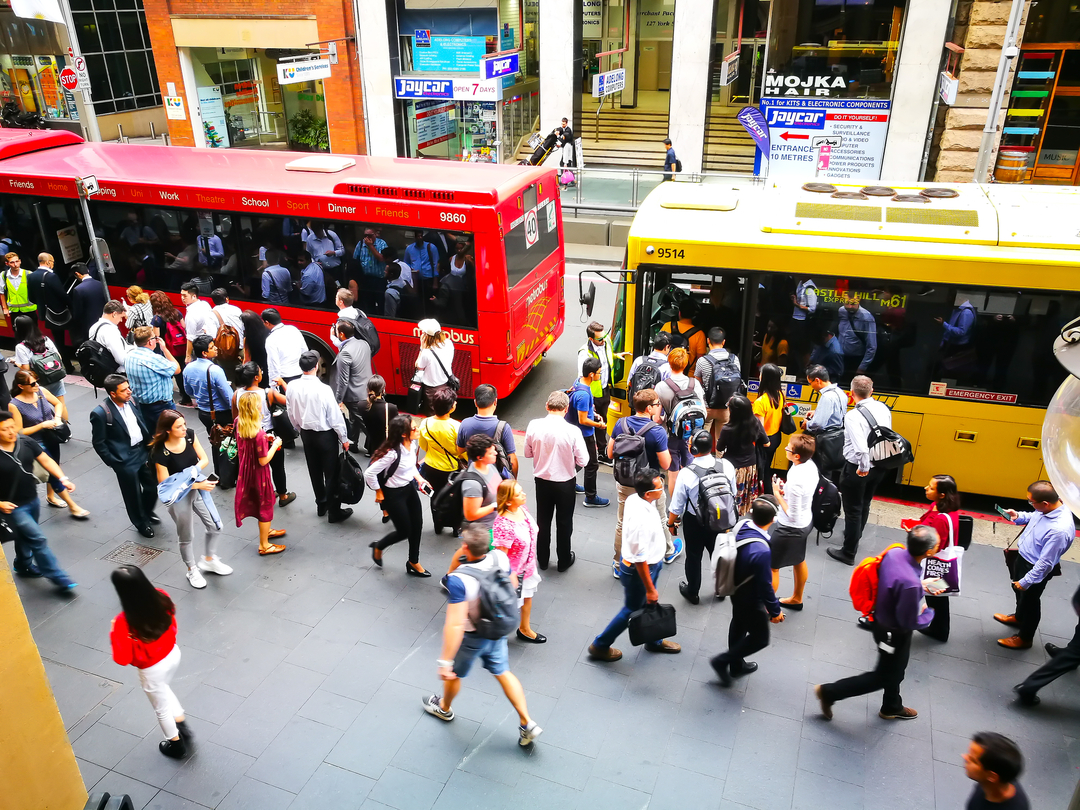Willem Klumpenhouwer is a Postdoctoral Fellow at the Transit Analytics Lab in the University of Toronto’s Department of Civil and Mineral Engineering. Willem created this blog to highlight the report he wrote on demand-responsive transit in Canada. You can read the full report here.
is a Postdoctoral Fellow at the Transit Analytics Lab in the University of Toronto’s Department of Civil and Mineral Engineering. Willem created this blog to highlight the report he wrote on demand-responsive transit in Canada. You can read the full report here.
Public transit is one big compromise. When it works, it’s because individuals make small choices and concessions to achieve a greater collective efficiency. Our willingness to wait for a bus, transfer, and share our time and space with other people, as well as our choice of where and how we live, are all things that impact how well a transit system works. In return, we get a sustainable, efficient way to move around.
In the suburbs, and to a certain extent in smaller towns, these trade-offs become less efficient. Curvy roads, parking lots, spaced-out single-family homes, and expressways all degrade transit’s ability to deliver efficient and cost-effective transit. In these areas, municipalities have turned to demand-responsive transit as a potential alternative to a traditional fixed-route transit service to connect residents with the rest of the city.
Demand-responsive transit encompasses a wide variety of possible services that connect multiple individuals and origin-destination pairs with dynamic scheduling and routing. Customers request a transit trip through a website or smartphone app, and a vehicle meets them at their stop to take them to their destination, stopping to serve others on the way.
Beyond that, the service can take on many forms. In my recent research project with the University of Toronto’s Transit Analytics lab, OSPE, and Mitacs, I outlined what I called the “spectrum of demand-responsive transit” (see the figure below) currently in operation across Canada.

The Spectrum of Demand-Responsive Transit
Microtransit, or more generically “ride sharing”, is just barely a transit service. Taxis (or traditional Uber and Lyft rides) serve one origin-destination pair at a time, while transit serves many. Vehicles are typically sedans or small vans, designed to carry very few simultaneous passengers. With microtransit, the design of the system means that the passenger-to-operator ratio is quite low, leading to higher costs for the transit agency. That can translate to less service, higher fares, or an increased subsidy.
Microtransit has recently become a hot topic in Ontario. The province has asked Toronto to consider replacing low-performing bus routes with a ‘microtransit alternative’ as a condition of receiving further COVID-19 transit support from the province. The ensuing discussion made it clear that while microtransit has a buzz about it, the range of possibilities enabled by recent advances in demand-responsive transit systems are not well known. Proponents seem mesmerized by Innisfil, and Ontario’s partnership with venture-capital-backed Uber there, while critics claim that microtransit offers very little to cities with established transit services. One criticism is that any savings are often a result of lower non-unionized operator wages and decreased service availability instead of actual efficiency.
At the other end of the demand-responsive transit spectrum is traditional fixed-route service. In this the goal is collective and shared; individuals meet at a fixed stop and move around the system, often transferring from one route to another.

What’s missing from the conversation is the wide variety of possibilities between these two ends of the spectrum, and their respective trade-offs.
This is where the recent technological advances really shine. Cloud computing platforms allow routing algorithms to constantly optimize and update their choices based on real-time information. Smartphones allow customers with access to easily and quickly book a trip, and receive accurate feedback on the location of their vehicle and their pickup time. This real-time adjustment opens the door for more flexibility in the design of the service that wasn’t available before.
Where a system falls on this spectrum emerges from the parameters set by the operator and the software developer. By increasing zone size and the number of stops in a zone served, the operator can provide service to a larger area, at the expense of trip directness. A large area allows a single bus to offer service to a large number of individuals, but it becomes more sensitive to changes in demand patterns. Lots of criss-cross trips in a zone can easily overwhelm such a service, requiring additional vehicles to be added.
The algorithms can also be tweaked to provide very different types of service. Setting a maximum in-vehicle travel time limits the amount of circuitous routing that a vehicle can do to pick up multiple individuals. This creates more direct trips for the customer, but lowers the amount of sharing in the vehicle, which in turn lowers productivity and cost-effectiveness. Typically, operators set the maximum in-vehicle time for customers as a factor of the direct-trip time (e.g. a factor of 2 means that a rider should never spend more than twice the direct-trip time in the vehicle).
Capacity can also be adjusted easily. In traditional fixed-route service, passengers arrive at stops somewhat randomly, and the actual demand for a given bus on a route fluctuates. With demand-responsive transit, requiring trip booking means that the number of passengers on board at any given time is known exactly. This is especially useful during the Coronavirus pandemic, when the capacity of vehicles can be limited for physical distancing purposes.
By adjusting these parameters, a demand-responsive transit service can move along the spectrum of individual service and collective and shared service. Microtransit services such as UberPool tend to serve vast geographical areas (an entire city or neighbourhood) with many vehicles (private automobiles), serving a large number of possible stops (individual houses, in some cases). The algorithm tends to favour direct or similar trips, leading to relatively low levels of sharing. This means lower cost effectiveness.
There are lots of other options on that spectrum. Finding the balance between cost-effectiveness and level of service is important and is a major area of study in the demand-responsive world. Each community, town, and city is different in its needs, and the flexibility of these parameters are what makes demand-responsive transit a possible alternative in these areas.
This is where the conversation on demand-responsive transit should be. Where, on the wide spectrum of possibilities, does a given community land? If demand-responsive transit is appropriate at all, should the focus be on collective and shared service or individualized mobility? The answers to these questions take time, data, and study, but they will serve our cities better.
In his 2019 synthesis of demand-responsive transit in the United States, Joel Volinski summarizes this all very neatly: “General public [demand-responsive] transit service is the chameleon of the public transportation world…It is another tool in the toolbox available to public transit agencies as they try to provide [appropriate supply] to match the various levels of demand in their diverse service areas”.
In the “tool in the toolbox” metaphor, demand-responsive transit is like a ratchet set. Many options are available, it’s a matter of choosing the right fit.
To read Willem’s full report “The State of Demand-Responsive Transit in Canada” click here!
A special thanks to our partners that helped make this report possible:







Leave a Comment